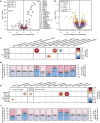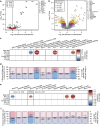Gene expression in human brain implicates sexually dimorphic pathways in autism spectrum disorders
- PMID: 26892004
- PMCID: PMC4762891
- DOI: 10.1038/ncomms10717
Gene expression in human brain implicates sexually dimorphic pathways in autism spectrum disorders
Abstract
Autism spectrum disorder (ASD) is more prevalent in males, and the mechanisms behind this sex-differential risk are not fully understood. Two competing, but not mutually exclusive, hypotheses are that ASD risk genes are sex-differentially regulated, or alternatively, that they interact with characteristic sexually dimorphic pathways. Here we characterized sexually dimorphic gene expression in multiple data sets from neurotypical adult and prenatal human neocortical tissue, and evaluated ASD risk genes for evidence of sex-biased expression. We find no evidence for systematic sex-differential expression of ASD risk genes. Instead, we observe that genes expressed at higher levels in males are significantly enriched for genes upregulated in post-mortem autistic brain, including astrocyte and microglia markers. This suggests that it is not sex-differential regulation of ASD risk genes, but rather naturally occurring sexually dimorphic processes, potentially including neuron-glial interactions, that modulate the impact of risk variants and contribute to the sex-skewed prevalence of ASD.
Conflict of interest statement
D.H.G. serves on the scientific advisory board for SynapDx. The remaining authors declare no competing financial interests.
Figures




Similar articles
-
Neural Transcriptomic Analysis of Sex Differences in Autism Spectrum Disorder: Current Insights and Future Directions.Biol Psychiatry. 2022 Jan 1;91(1):53-60. doi: 10.1016/j.biopsych.2020.11.023. Epub 2020 Dec 7. Biol Psychiatry. 2022. PMID: 33551190 Review.
-
Possible sexually dimorphic role of miRNA and other sncRNA in ASD brain.Mol Autism. 2017 Feb 7;8:4. doi: 10.1186/s13229-017-0117-0. eCollection 2017. Mol Autism. 2017. PMID: 28184278 Free PMC article.
-
RNA sequencing of transformed lymphoblastoid cells from siblings discordant for autism spectrum disorders reveals transcriptomic and functional alterations: Evidence for sex-specific effects.Autism Res. 2017 Mar;10(3):439-455. doi: 10.1002/aur.1679. Epub 2016 Aug 16. Autism Res. 2017. PMID: 27529825
-
SLC9A9 Co-expression modules in autism-associated brain regions.Autism Res. 2017 Mar;10(3):414-429. doi: 10.1002/aur.1670. Epub 2016 Jul 21. Autism Res. 2017. PMID: 27439572
-
Genetics and Epigenetics of One-Carbon Metabolism Pathway in Autism Spectrum Disorder: A Sex-Specific Brain Epigenome?Genes (Basel). 2021 May 20;12(5):782. doi: 10.3390/genes12050782. Genes (Basel). 2021. PMID: 34065323 Free PMC article. Review.
Cited by
-
Sleep problems in autism: Sex differences in the school-age population.Autism Res. 2023 Jan;16(1):164-173. doi: 10.1002/aur.2848. Epub 2022 Nov 7. Autism Res. 2023. PMID: 36341856 Free PMC article.
-
Does prenatal stress alter the developing connectome?Pediatr Res. 2017 Jan;81(1-2):214-226. doi: 10.1038/pr.2016.197. Epub 2016 Sep 27. Pediatr Res. 2017. PMID: 27673421 Free PMC article. Review.
-
Tissue-wide cell-specific proteogenomic modeling reveals novel candidate risk genes in autism spectrum disorders.NPJ Syst Biol Appl. 2022 Sep 6;8(1):31. doi: 10.1038/s41540-022-00243-8. NPJ Syst Biol Appl. 2022. PMID: 36068227 Free PMC article.
-
Genetic Causes and Modifiers of Autism Spectrum Disorder.Front Cell Neurosci. 2019 Aug 20;13:385. doi: 10.3389/fncel.2019.00385. eCollection 2019. Front Cell Neurosci. 2019. PMID: 31481879 Free PMC article. Review.
-
Reelin cells and sex-dependent synaptopathology in autism following postnatal immune activation.Br J Pharmacol. 2022 Sep;179(17):4400-4422. doi: 10.1111/bph.15859. Epub 2022 May 23. Br J Pharmacol. 2022. PMID: 35474185 Free PMC article.
References
-
- American Psychiatric Association. Diagnostic and Statistical Manual of Mental Disorders 5th edn American Psychiatric Association (2013).
-
- Wingate M. et al. Prevalence of autism spectrum disorder among children aged 8 years—Autism and Developmental Disabilities Monitoring Network, 11 sites, United States, 2010. MMWR Surveill. Summ. 63, 1–21 (2014). - PubMed
Publication types
MeSH terms
Grants and funding
- R01 MH094714/MH/NIMH NIH HHS/United States
- F31MH093086/MH/NIMH NIH HHS/United States
- T32 MH073526/MH/NIMH NIH HHS/United States
- T32MH073526/MH/NIMH NIH HHS/United States
- F30MH099886/MH/NIMH NIH HHS/United States
- F31 MH093086/MH/NIMH NIH HHS/United States
- R01 MH100027/MH/NIMH NIH HHS/United States
- 9R01MH100027/MH/NIMH NIH HHS/United States
- 5R37MH060233/MH/NIMH NIH HHS/United States
- R37 MH060233/MH/NIMH NIH HHS/United States
- RC2 MH089921/MH/NIMH NIH HHS/United States
- 5R01MH094714/MH/NIMH NIH HHS/United States
- F30 MH099886/MH/NIMH NIH HHS/United States
- 5RC2MH089921/MH/NIMH NIH HHS/United States
LinkOut - more resources
Full Text Sources
Other Literature Sources
Medical
Molecular Biology Databases

